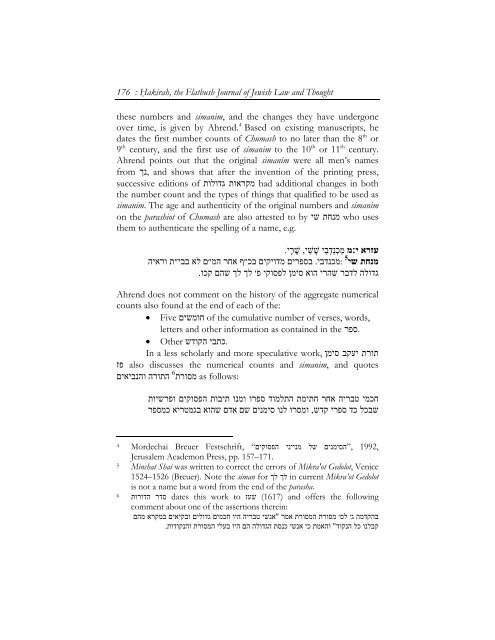Symmetrically Designed Sifrei Torah: A Quantitative Analysis - Hakirah
Symmetrically Designed Sifrei Torah: A Quantitative Analysis - Hakirah
Symmetrically Designed Sifrei Torah: A Quantitative Analysis - Hakirah
You also want an ePaper? Increase the reach of your titles
YUMPU automatically turns print PDFs into web optimized ePapers that Google loves.
176 : Hạkirah, the Flatbush Journal of Jewish Law and Thought<br />
these numbers and simanim, and the changes they have undergone<br />
over time, is given by Ahrend. 4 Based on existing manuscripts, he<br />
dates the first number counts of Chumash to no later than the 8 th or<br />
9 th century, and the first use of simanim to the 10 th or 11 th century.<br />
Ahrend points out that the original simanim were all men’s names<br />
from ,נך and shows that after the invention of the printing press,<br />
successive editions of מקראות גדולות had additional changes in both<br />
the number count and the types of things that qualified to be used as<br />
simanim. The age and authenticity of the original numbers and simanim<br />
on the parashiot of Chumash are also attested to by מנחת שי who uses<br />
them to authenticate the spelling of a name, e.g.<br />
עזרא י׃מ מַכְנַדְבַי שָׁשַׁי, שָׁרָי.<br />
מנחת שי :מכנדבי. בספרים מדויקים בכ״ף אחר המ״ם לא בבי״ת וראיה<br />
גדולה לדבר שהרי הוא סימן לפסוקי פ׳ לך לך שהם קכו.<br />
Ahrend does not comment on the history of the aggregate numerical<br />
counts also found at the end of each of the:<br />
• Five חומשים of the cumulative number of verses, words,<br />
.ספר letters and other information as contained in the<br />
.כתבי הקודש • Other<br />
תורת יעקב סימן work, In a less scholarly and more speculative<br />
also discusses the numerical counts and simanim, and quotes פז<br />
6<br />
as follows:<br />
מסורת התורה והנביאים<br />
חכמי טבריה אחר חתימת התלמוד ספרו ומנו תיבות הפסוקים ופרשיות<br />
שבכל כד ספרי קדש, ומסרו לנו סימנים שם אדם שהוא בגמטריא כמספר<br />
5<br />
1992, ,”הסימנים של מנייני הפסוקים“ Festschrift, 4 Mordechai Breuer<br />
Jerusalem Academon Press, pp. 157–171.<br />
5 Minchat Shai was written to correct the errors of Mikra'ot Gedolot, Venice<br />
1524–1526 (Breuer). Note the siman for לך לך in current Mikra’ot Gedolot<br />
is not a name but a word from the end of the parasha.<br />
(1617) and offers the following שע ז dates this work to סדר הדורות 6<br />
comment about one of the assertions therein:<br />
בהקדמה ג׳ לס׳ מסורת המסורת אמר "אנשי טבריה היו חכמים גדולים ובקיאים במקרא מהם<br />
קבלנו כל הנקוד" והאמת כי אנשי כנסת הגדולה הם היו בעלי המסורת והנקודות.
















